Detection of Structural Damage in a Shaking Table Test Based on an Auto-Regressive Model with Additive Noise
Abstract
:1. Introduction
2. LS Adjustment for the AR Model with Additive Noise
2.1. AR Model with Additive Noise
2.2. Existing TLS Solutions for the EIV Model
2.3. TLS Solution for the Modified AR Model
- Given and , , ;
- Initialize ;
- Compute by Equation (13);
- Compute by Equation (14) based on the obtained in Step 3.
- Given a predetermined tolerable error value, if the errors between and are within the given value, terminate the estimation. Otherwise, go to Step 3.
2.4. Damage Detection Indicator
- 1
- The obtained response acceleration time-series data are divided into two parts, i.e., part and part , where is used as the baseline data and serves as the unknown data to be estimated when there is damage to the structure.
- 2
- Estimating and through Equations (12) and (13). The square of the Euclidean distance between with is calculated as:
- 3
- Estimating the of ith output data of the damaged structure through Equations (12) and (13). The Euclidean distance between and is calculated as,
- 4
- Finally, the damage indicator, named IF in this paper, is calculated as the ratio between and , as follows:
3. Performance Analysis
4. Experimental and Numerical Techniques
4.1. Shaking Table Model Test
4.2. Finite Element Simulation
5. Experimental, Numerical, and Identification Results
5.1. Experimental Results and Analysis
5.2. Finite Element Simulation Results
5.3. Damage Detection Results
6. Conclusions
Author Contributions
Funding
Data Availability Statement
Conflicts of Interest
References
- Sarah, J.; Hejazi, F.; Rashid, R.S.; Ostovar, N. A Review of Dynamic Analysis in Frequency Domain for Structural Health Monitoring. IOP Conf. Series Earth Environ. Sci. 2019, 357, 012007. [Google Scholar] [CrossRef]
- Xiao, F.; Sun, H.; Mao, Y.; Chen, G.S. Damage identification of large-scale space truss structures based on stiffness separation method. Structures 2023, 53, 109–118. [Google Scholar] [CrossRef]
- Huynh, N.T.; Nguyen, T.V.; Nguyen, Q.M. Optimum Design for the Magnification Mechanisms Employing Fuzzy Logic-ANFIS. Comput. Mater. Contin. 2022, 12, 5961–5983. [Google Scholar]
- Huynh, N.T.; Nguyen, T.V.; Tam, N.T.; Nguyen, Q.M. Optimizing Magnification Ratio for the Flexible Hinge Displacement Amplifier Mechanism Design. In International Conference on Material, Machines and Methods for Sustainable Development MMMS 2020, Proceedings of the 2nd Annual International Conference on Material, Nha Trang, Vietnam, 12–15 November 2020; Springer: Cham, Switzerland, 2020; pp. 769–778. [Google Scholar]
- Ni, H.; Li, M.H.; Zuo, X. Review on Damage Identification and Diagnosis Research of Civil Engineering Structure. Adv. Mater. Res. 2014, 1006–1007, 34–37. [Google Scholar] [CrossRef]
- Wang, Y.; Gu, Y.; Liu, J. A domain-decomposition generalized finite difference method for stress analysis in three-dimensional composite materials. Appl. Math. Lett. 2020, 104, 106226. [Google Scholar] [CrossRef]
- Kabir, H.; Aghdam, M.M. A generalized 2D Bézier-based solution for stress analysis of notched epoxy resin plates reinforced with graphene nanoplatelets. Thin Walled Struct. 2021, 169, 108484. [Google Scholar] [CrossRef]
- Bert, C.W.; Malik, M. Differential quadrature: A powerful new technique for analysis of composite structures. Compos. Struct. 1997, 39, 179–189. [Google Scholar] [CrossRef]
- Ahn, S.; Park, G.; Yoon, H.; Han, J.-H.; Jung, J. Evaluation of Soil–Structure Interaction in Structure Models via Shaking Table Test. Sustainability 2021, 13, 4995. [Google Scholar] [CrossRef]
- Xiao, F.; Zhu, W.; Meng, X.; Chen, G.S. Parameter Identification of Frame Structures by considering Shear Deformation. Int. J. Distrib. Sens. Netw. 2023, 2023, 6631716. [Google Scholar] [CrossRef]
- Xiao, F.; Zhu, W.; Meng, X.; Chen, G.S. Parameter Identification of Structures with Different Connections Using Static Responses. Appl. Sci. 2022, 12, 5896. [Google Scholar] [CrossRef]
- Kopsaftopoulos, F.P.; Fassois, S.D. Vibration based health monitoring for a lightweight truss structure: Experimental assessment of several statistical time series methods (conference paper). Mech. Syst. Signal Process. 2010, 24, 1977–1997. [Google Scholar] [CrossRef]
- He, J.; Chen, J.; Ren, X.; Li, J. A shake table test study of reinforced concrete shear wall model structures exhibiting strong non-linear behaviors. Eng. Struct. 2020, 212, 110481. [Google Scholar] [CrossRef]
- Moaveni, B.; He, X.; Conte, J.P.; Restrepo, J.I. Damage identification study of a seven-story full-scale building slice tested on the UCSD-NEES shake table. Struct. Saf. 2010, 32, 347–356. [Google Scholar] [CrossRef]
- Li, S.; Wu, C.; Kong, F. Shaking Table Model Test and Seismic Performance Analysis of a High-Rise RC Shear Wall Structure. Shock. Vib. 2019, 2019, 6189873. [Google Scholar] [CrossRef]
- Wu, C.; Li, S.; Zhang, Y. Structural Damage Identification Based on AR Model with Additive Noises Using an Improved TLS Solution. Sensors 2019, 19, 4341. [Google Scholar] [CrossRef] [PubMed]
- Hakim SJ, S.; Mokhatar, S.; Shahidan, S.; Chik, T.; Jaini, Z.; Ghafar, N.A.; Kamarudin, A. An ensemble neural network for damage identification in steel girder bridge structure using vibration data. Civ. Eng. Archit. 2021, 9, 523–532. [Google Scholar] [CrossRef]
- Wickramasinghe, W.R.; Thambiratnam, D.P.; Chan, T.H.T.; Nguyen, T. Vibration characteristics and damage detection in a suspension bridge. J. Sound Vib. 2016, 375, 254–274. [Google Scholar] [CrossRef]
- Morita, K.; Teshigawara, M.; Hamamoto, T. Detection and estimation of damage to steel frames through shaking table tests. Struct. Control. Health Monit. 2005, 12, 357–380. [Google Scholar] [CrossRef]
- Chen, W. Auto-Regressive Model Estimation Theory and Its Application in Deformation Monitoring Data Processing. Ph.D. Thesis, Wuhan University, Wuhan, China, 2013. [Google Scholar]
- Binder, M.D.; Hirokawa, N.; Windhorst, U. Auto-Regressive Model; Springer: Berlin/Heidelberg, Germany, 2008. [Google Scholar]
- Bernagozzi, G.; Achilli, A.; Betti, R.; Diotallevi, P.P.; Landi, L.; Quqa, S.; Tronci, E.M. On the use of multivariate autoregressive models for vibration-based damage detection and localization. Smart Struct. Syst. 2021, 27, 335–350. [Google Scholar]
- Zheng, W.X. A least-squares based method for autoregressive signals in the presence of noise. IEEE Trans. Circuits Syst. Part II Analog. Digit. Signal Process. 1999, 46, 81–85. [Google Scholar] [CrossRef]
- Diversi, R.; Guidorzi, R.; Soverini, U. Identification of autoregressive models in the presence of additive noise. Int. J. Adapt. Control. Signal Process. 2008, 22, 465–481. [Google Scholar] [CrossRef]
- Zeng, W. Effect of the Random Design Matrix on Adjustment of an EIV Model and Its Reliability Theory. Ph.D. Thesis, Wuhan University, Wuhan, China, 2013. [Google Scholar]
- Diversi, R.; Soverini, U.; Guidorzi, R. A new estimation approach for AR models in presence of noise. IFAC Proc. Vol. 2005, 38, 160–165. [Google Scholar] [CrossRef]
- Esfandiari, M.; Vorobyov, S.A.; Karimi, M. New estimation methods for autoregressive process in the presence of white observation noise. Signal Process. 2020, 171, 107480. [Google Scholar] [CrossRef]
- Guidorzi, R.; Diversi, R. Structural health monitoring application of errors-in-variables identification. In Proceedings of the 2013 21st Mediterranean Conference on Control and Automatino (MED), Platanias, Greece, 25–28 June 2013; Volume 2013, pp. 1098–1103. [Google Scholar]
- Mahboub, V.; Amiri-Simkooei, A.; Sharifi, M. Iteratively reweighted total least squares: A robust estimation in errors-invariables models. Surv. Rev. 2013, 45, 92–99. [Google Scholar] [CrossRef]
- Datteo, A.; Busca, G.; Quattromani, G.; Cigada, A. On the use of AR models for SHM: A global sensitivity and uncertainty analysis framework. Reliab. Eng. Syst. Saf. 2018, 170, 99–115. [Google Scholar] [CrossRef]
- Xu, P.; Liu, J.; Shi, C. Total least squares adjustment in partial errors-in-variables models: Algorithm and statistical analysis. J. Geodesy 2012, 86, 661–675. [Google Scholar] [CrossRef]
- Xu, P. The effect of errors-in-variables on variance component estimation. J. Geodesy 2016, 90, 681–701. [Google Scholar] [CrossRef]
- Khorshidi, S.; Karimi, M. Finite Sample FPE and AIC Criteria for Autoregressive Model Order Selection Using Same-Realization Predictions. EURASIP J. Adv. Signal Process. 2010, 2009, 475147. [Google Scholar] [CrossRef]
- Code for Seismic Design of Buildings (GB50011-2010); Ministry of Housing and Urban Rural Development of the People’s Republic of China; China Architecture & Building Press: Beijing, China, 2010.

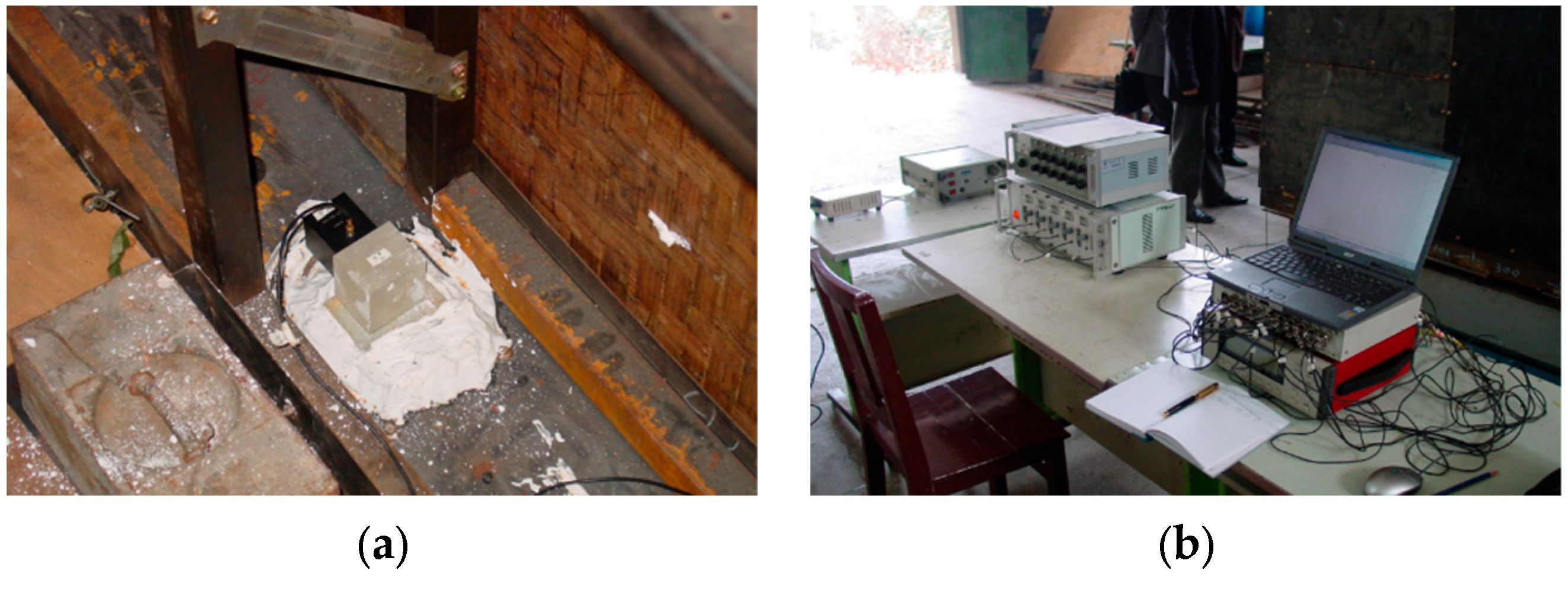
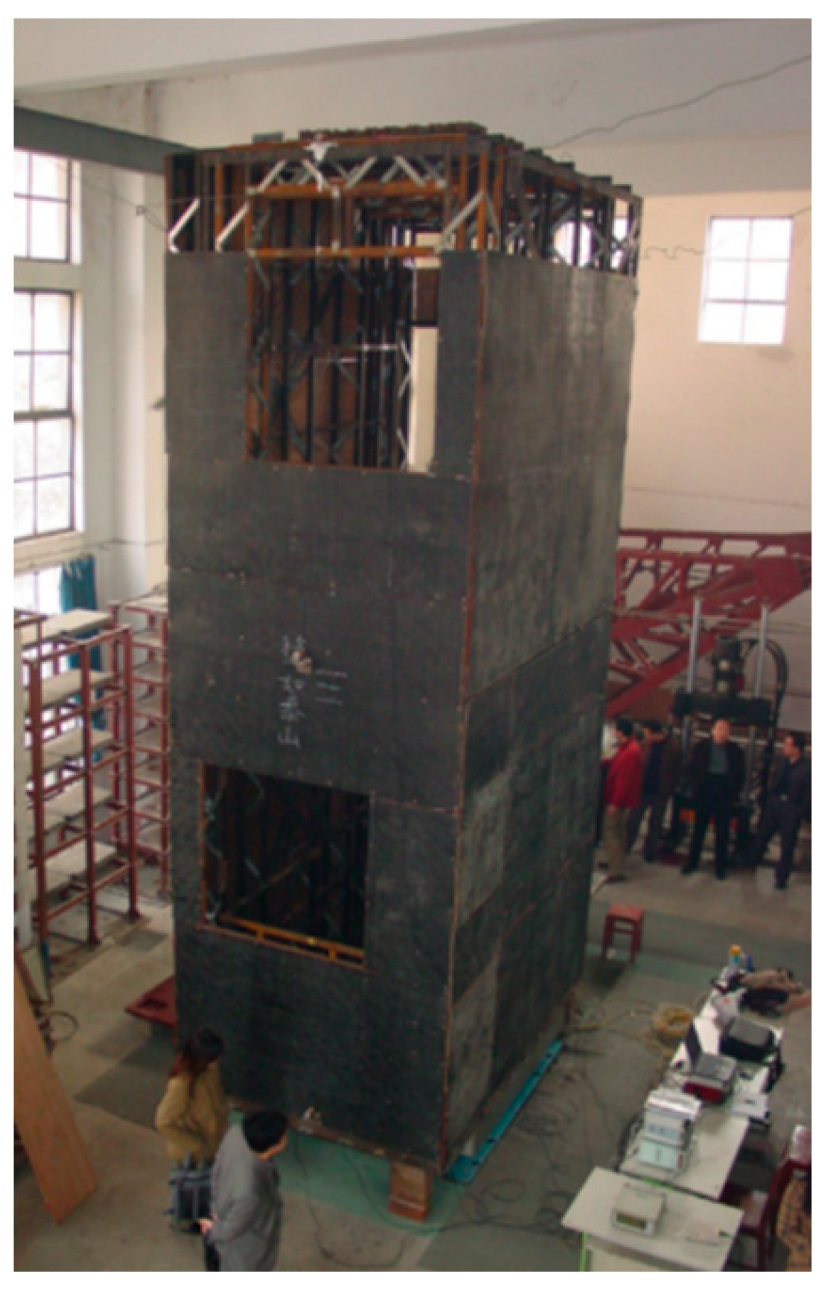
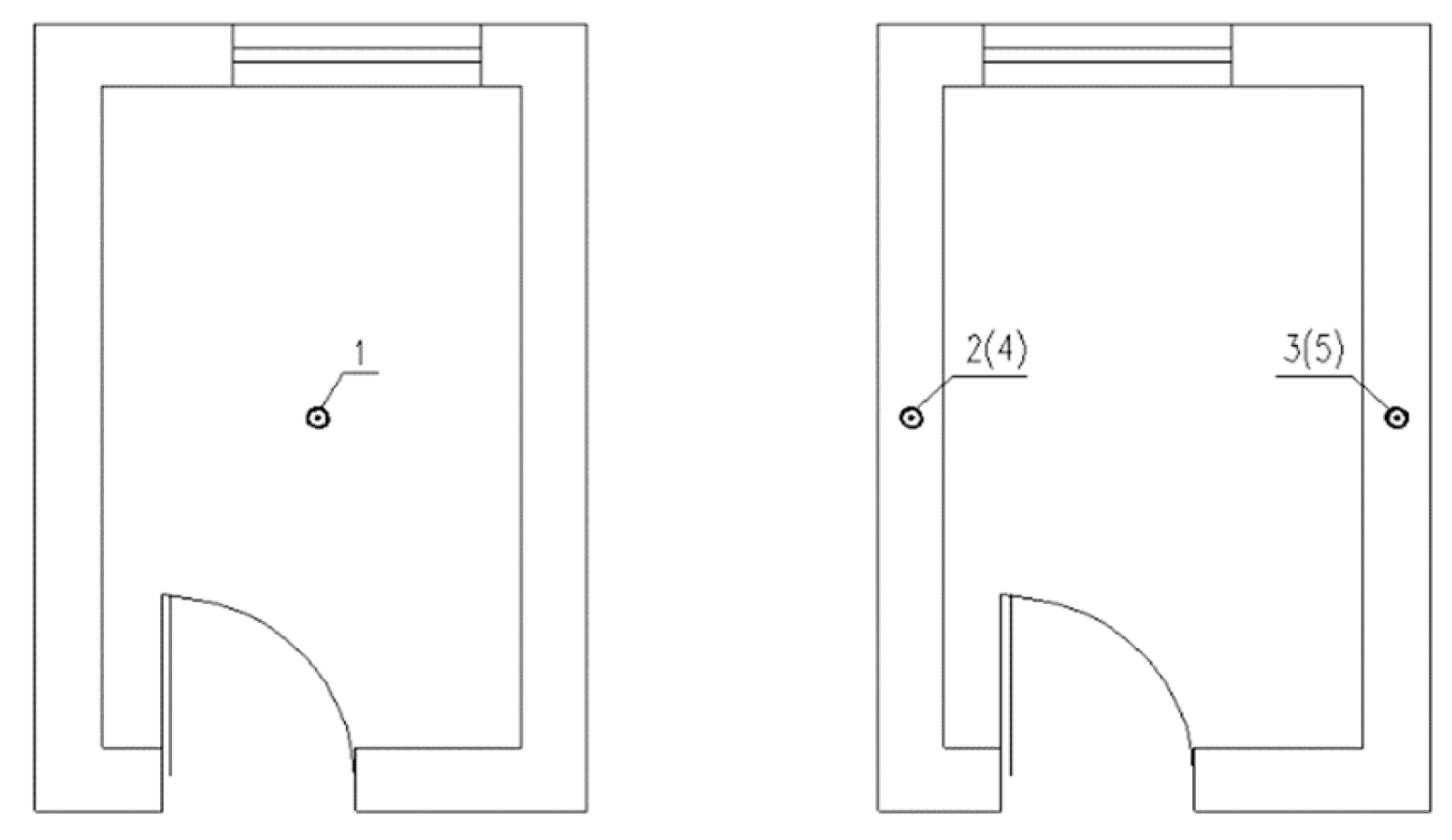

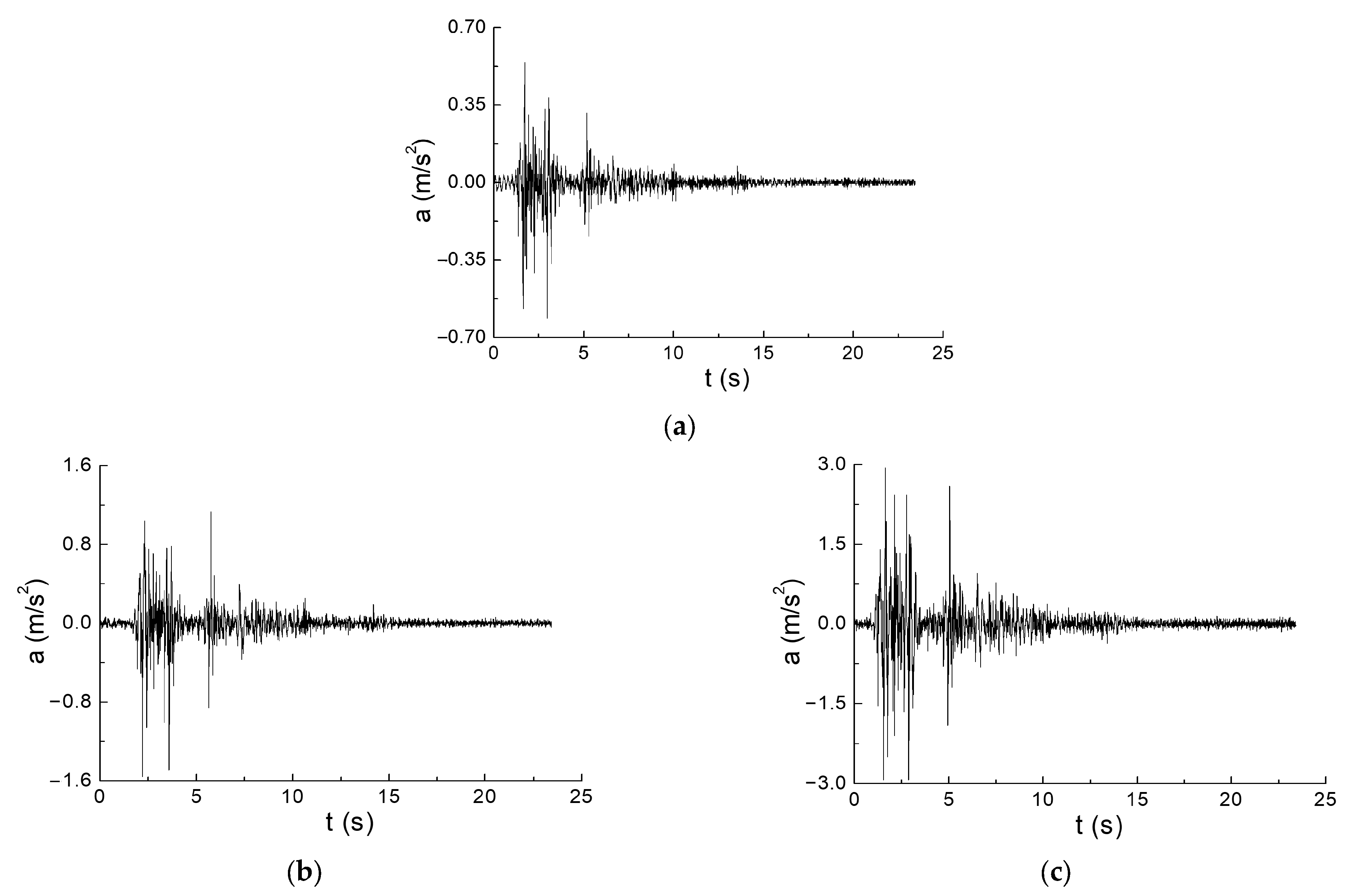

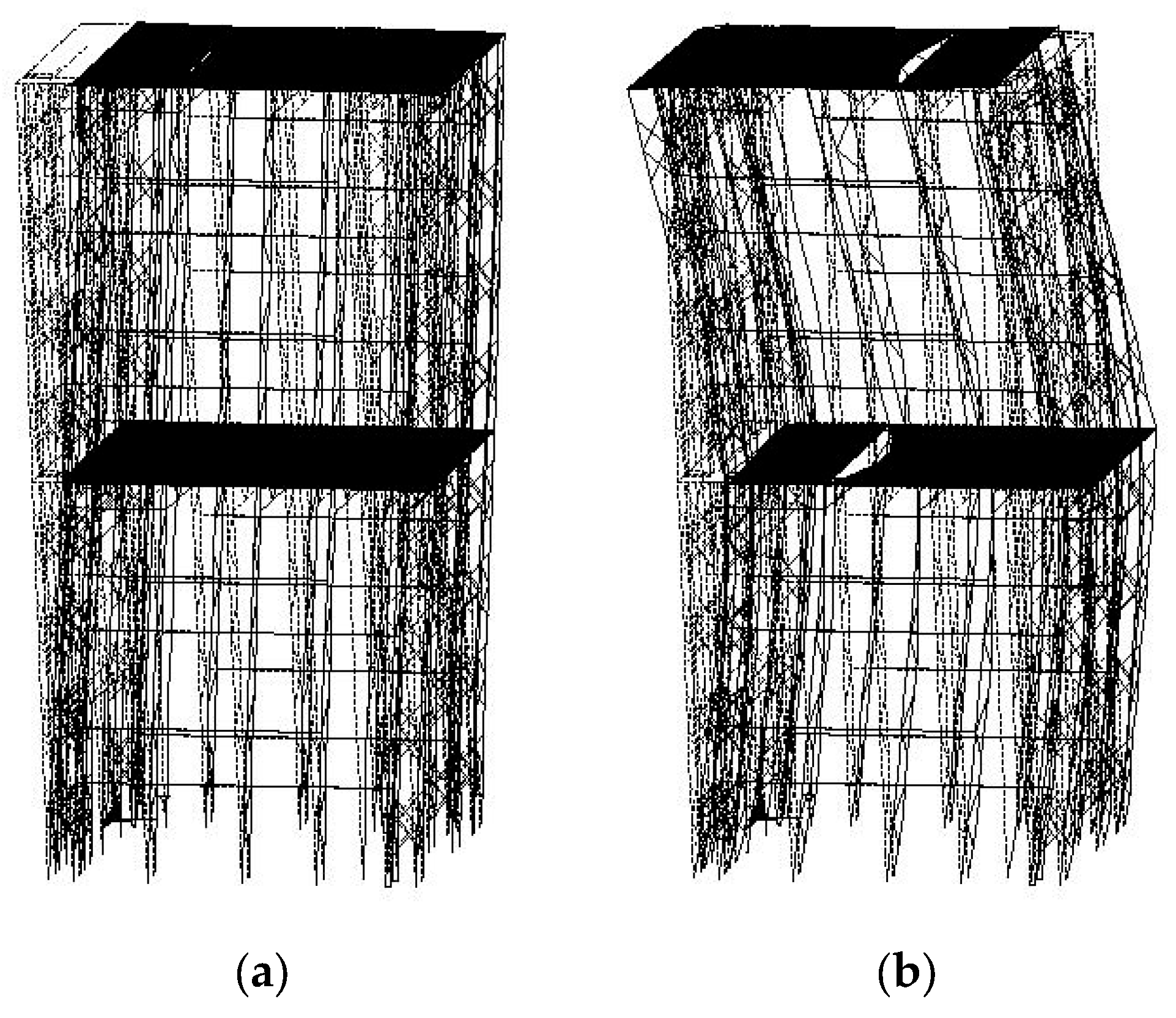



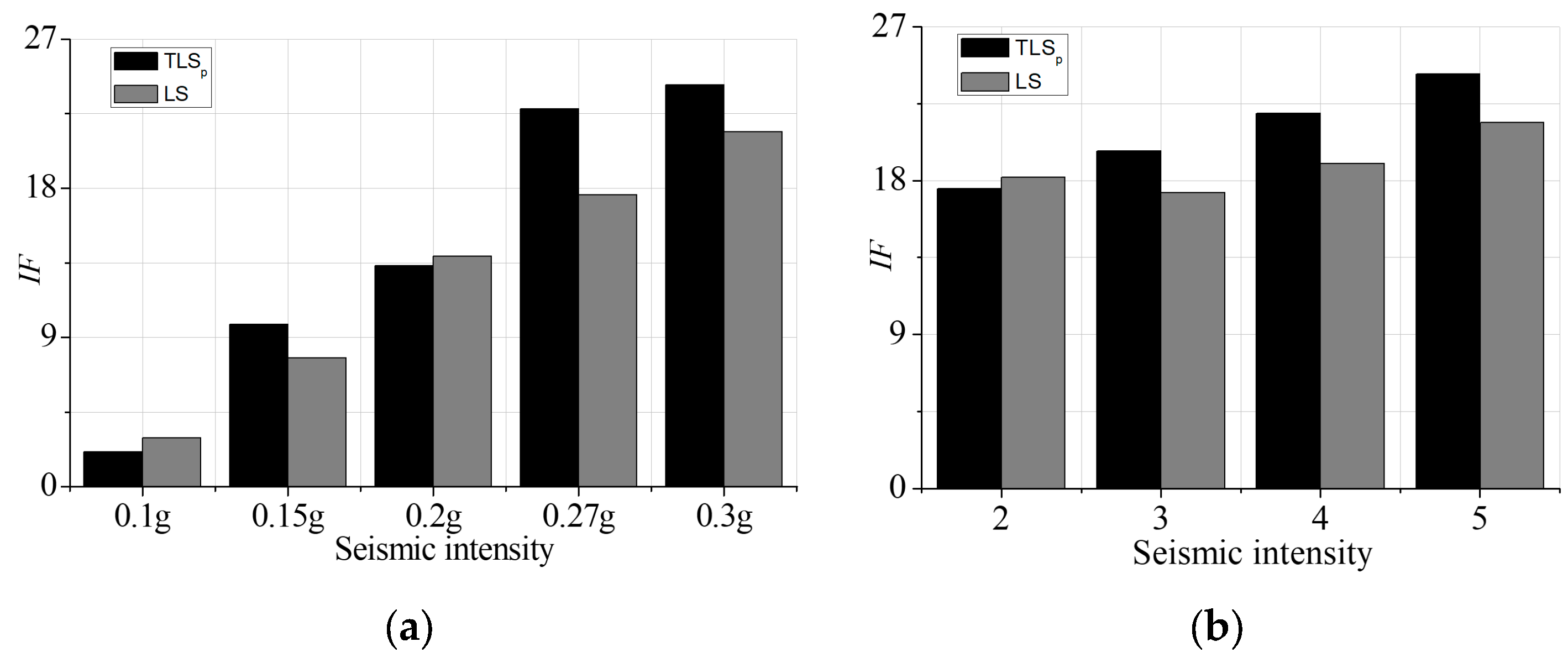
| SNR/dB | NO | 60 | 50 | 40 | 30 | 20 | 10 | |
|---|---|---|---|---|---|---|---|---|
| LS | 2.4 | 2.4001 | 2.3966 | 2.3942 | 2.3714 | 2.3357 | 2.2017 | |
| −3.03 | −3.0298 | −3.0233 | −3.0224 | −2.9820 | −2.9456 | −2.5086 | ||
| 1.986 | 1.9859 | 1.9793 | 1.9795 | 1.9452 | 1.8973 | 1.4482 | ||
| −0.6586 | −0.6584 | −0.6557 | −0.6562 | −0.6486 | −0.6162 | −0.4064 | ||
| TLSp | 2.4 | 2.4001 | 2.3966 | 2.3944 | 2.3736 | 2.3563 | 2.2818 | |
| −3.03 | −3.0298 | −3.0234 | −3.0228 | −2.9860 | −2.9840 | −2.6567 | ||
| 1.986 | 1.9859 | 1.9793 | 1.9799 | 1.9491 | 1.9340 | 1.5899 | ||
| −0.6586 | −0.6584 | −0.6557 | −0.6564 | −0.6500 | −0.6301 | −0.4600 | ||
| SNR/dB | 60 | 50 | 40 | 30 | 20 | 10 |
|---|---|---|---|---|---|---|
| LS | 2.22 | 2.20 10 | 2.79 102 | 9.80 102 | 4.18 103 | 1.33 105 |
| TLSp | 2.16 | 2.18 10 | 2.50 102 | 8.20 102 | 1.50 103 | 6.99 104 |
| Sequence Number | Input Seismic Wave | PGA (g) |
|---|---|---|
| 1 | Free vibration | |
| 2 | Sweeping (0–30 Hz) | 0.02 |
| 3 | Sweeping (30–0 Hz) | 0.02 |
| 4 | El Centro wave, Qian’an waves | 0.1 |
| 5 | El Centro wave | 0.15 |
| 6 | El Centro wave, Qian’an waves | 0.2 |
| 7 | El Centro wave, | 0.27 |
| 8 | El Centro wave, Taft wave | 0.3 |
| Components | Elastic Modulus (N/mm2) | Yield Strength (N/mm2) | Tensile Strength (N/mm2) | Tensibility |
|---|---|---|---|---|
| Square steel tube | 2.02 × 105 | 299.6 | 330.1 | 19% |
| Rectangular tube | 2.42 × 105 | 279.9 | 334.5 | 19% |
| Connector | 2.45 × 105 | 361.1 | 374.3 | 14% |
| Steel band | 1.75 × 105 | 228.4 | 333.1 | 35% |
| Condition | First Order (Hz) | Second Order (Hz) | Damping Ratio |
|---|---|---|---|
| Free vibration | 4.42 | 14.2 | 1.2% |
| White noise | 4.26 | 14.4 | 1.7% |
| Sweeping (0–30 Hz) | 3.62 | 15.4 | 1.4% |
| Sweeping (30–0 Hz) | 3.83 | 13.9 | 1.5% |
| Test Conditions | Peak Displacement (mm) | Peak Acceleration (m/s2) | ||
|---|---|---|---|---|
| Second Floor | Top Floor | Second Floor | Top Floor | |
| El Centro wave (0.1 g) | 0.41 | 0.67 | 0.47 | 0.61 |
| El Centro wave (0.2 g) | 0.9 | 1.46 | 1.14 | 1.56 |
| El Centro wave (0.3 g) | 1.9 | 4.32 | 2.95 | 2.94 |
| Qian’an wave (0.1 g) | 0.39 | 0.14 | 0.32 | 0.62 |
| Qian’an wave (0.2 g) | 4.1 | 0.46 | 1.64 | 1.05 |
| Vibration Mode | Experiment | FE Simulation | |||
|---|---|---|---|---|---|
| Frequency (Hz) | Period (s) | Frequency (Hz) | Period (s) | ||
| Direction | First | 4.42 | 0.23 | 4.87 | 0.21 |
| Second | 14.2 | 0.07 | 15.01 | 0.067 | |
| Test Condition | Second Floor | Top Floor | ||||||
|---|---|---|---|---|---|---|---|---|
| Displacement (m/s2) | Acceleration (m/s2) | Displacement (m/s2) | Acceleration (m/s2) | |||||
| Experiment | FE | Experiment | FE | Experiment | FE | Experiment | FE | |
| 0.1 g | 0.41 | 0.5 | 0.47 | 0.56 | 0.67 | 0.63 | 0.61 | 0.69 |
| 0.2 g | 0.9 | 1.08 | 1.14 | 0.92 | 1.46 | 1.43 | 1.56 | 1.71 |
| 0.3 g | 2.7 | 2.49 | 2.95 | 3.07 | 4.32 | 3.91 | 2.94 | 3.17 |
Disclaimer/Publisher’s Note: The statements, opinions and data contained in all publications are solely those of the individual author(s) and contributor(s) and not of MDPI and/or the editor(s). MDPI and/or the editor(s) disclaim responsibility for any injury to people or property resulting from any ideas, methods, instructions or products referred to in the content. |
© 2023 by the authors. Licensee MDPI, Basel, Switzerland. This article is an open access article distributed under the terms and conditions of the Creative Commons Attribution (CC BY) license (https://creativecommons.org/licenses/by/4.0/).
Share and Cite
Xiao, Q.; Zhu, D.; Li, J.; Wu, C. Detection of Structural Damage in a Shaking Table Test Based on an Auto-Regressive Model with Additive Noise. Buildings 2023, 13, 2480. https://doi.org/10.3390/buildings13102480
Xiao Q, Zhu D, Li J, Wu C. Detection of Structural Damage in a Shaking Table Test Based on an Auto-Regressive Model with Additive Noise. Buildings. 2023; 13(10):2480. https://doi.org/10.3390/buildings13102480
Chicago/Turabian StyleXiao, Quanmao, Daopei Zhu, Jiazheng Li, and Cai Wu. 2023. "Detection of Structural Damage in a Shaking Table Test Based on an Auto-Regressive Model with Additive Noise" Buildings 13, no. 10: 2480. https://doi.org/10.3390/buildings13102480
APA StyleXiao, Q., Zhu, D., Li, J., & Wu, C. (2023). Detection of Structural Damage in a Shaking Table Test Based on an Auto-Regressive Model with Additive Noise. Buildings, 13(10), 2480. https://doi.org/10.3390/buildings13102480






